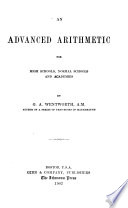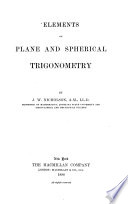 | Webster Wells - Algebra - 1904 - 384 pages
...logarithm is negative, and increases without limit in absolute value. (Compare Note to § 296.) 396. In any system, the logarithm of a product is equal...the logarithms of its factors. Assume the equations , . - 00_ ; whence by § 387, a" = ' Multiplying the assumed equations, a" x a» = mn, or a*•1•"... | |
 | Webster Wells - Algebra - 1897 - 386 pages
...со ; it must be interpreted as follows : 396. In any system, the logarithm of a product is equol to the sum of the logarithms of its factors. Assume the equations a* = m } , , , „„_ fx = log. m, ; whence by § 387, \ , 6e ' a» = nj' J '\y=logan. Multiplying the assumed... | |
 | George Albert Wentworth - 1898 - 424 pages
...following logarithms : 649. Since every factor of a product may be expressed as a power of ten (§ 628), The logarithm of a product is equal to the sum of the logarithms of its factors (§ 69). 650. Example. Find by logarithms the product of 908.4 X 0.05392 X 2.117. SOLUTION. log 908.4... | |
 | George Albert Wentworth - Arithmetic - 1898 - 424 pages
...following logarithms : 649. Since every factor of a product may be expressed as a power of ten (§ 628), The logarithm of a product is equal to the sum of the logarithms of its factors (§ 69). 650. Example. Find by logarithms the product of 908.4 X 0.05392 X 2.117. SOLUTION-. log 908.4... | |
 | George Albert Wentworth - Arithmetic - 1898 - 424 pages
...following logarithms : 649. Since every factor of a product may be expressed as a power of ten (§ 628), The logarithm of a product is equal to the sum of the logarithms of its factors (§ 69). 650. Example. Find by logarithms the product of 908.4 X 0.05392 X 2.117. SOLUTION. log 908.4... | |
 | James William Nicholson - Trigonometry - 1898 - 204 pages
...significant part of 2400. is 24 ; of 2.030, 203 ; of .00108, 108 ; of .00023070, 2307. 2. Principles. l. The logarithm of a product is equal to the sum of the logarithms of the factors. For, let a = 10°' . . (/), and b = 10'' . . . (g) then log a = a', and log b = b' (A)... | |
 | George Egbert Fisher - Algebra - 1899 - 506 pages
...40. lo&x = -fa. 41. logs 9 = 2. 42. log, 27 = - 3. 43. log* 8 = J. Principles of Logarithms. 15. TJie logarithm of a product is equal- to the sum of the logarithms of its factors; or, logs (mxn) = logs m + Iog6n. Let log;, m = x and logj n = y ; then 61 = m and 6" = n, and therefore,... | |
 | George Egbert Fisher - 1900 - 444 pages
...0. For b9 = 1, or Iogb 1 = 0. 5. The logarithm of the base itself is 1. For bl = b, or Iogb&=l. 6. The logarithm of a product is equal to the sum of the logarithms of its factors ; or, Let logb m = x and logb n = y ; then b" = m and b" = n, and therefore, mn = b*b8 = b'+'/. Translated... | |
 | James Morford Taylor - Algebra - 1900 - 504 pages
...= l, .-. log, 1 = 0. 440. The logarithm of the base itself is 1. Proof. a1 = a, .: loga a = 1. 441. The logarithm of a product is equal to the sum of the logarithms of its factors. Proof. Let M=ax, N=a!>; then M x N= ax+». § 346 Hence loge(3f y, N) = x + y = loga M -\- log. N.... | |
 | George Egbert Fisher - Algebra - 1900 - 438 pages
...is 0. For ba = 1, or logj 1 = 0. 5. The loganthm of the base itself is 1. For b1 = b, or logj&=1. 6. The logarithm of a product is equal to the sum of the loejurithms of its factors ; or, Let logj m = x and logj n = y ; then b* = m and № = n, and therefore,... | |
| |